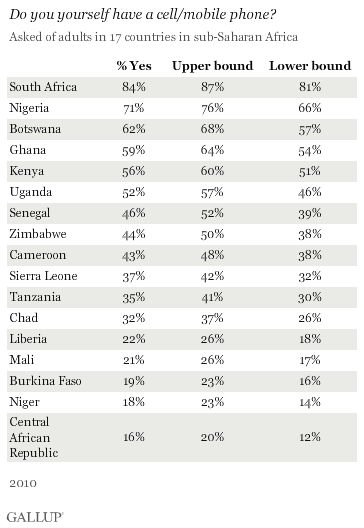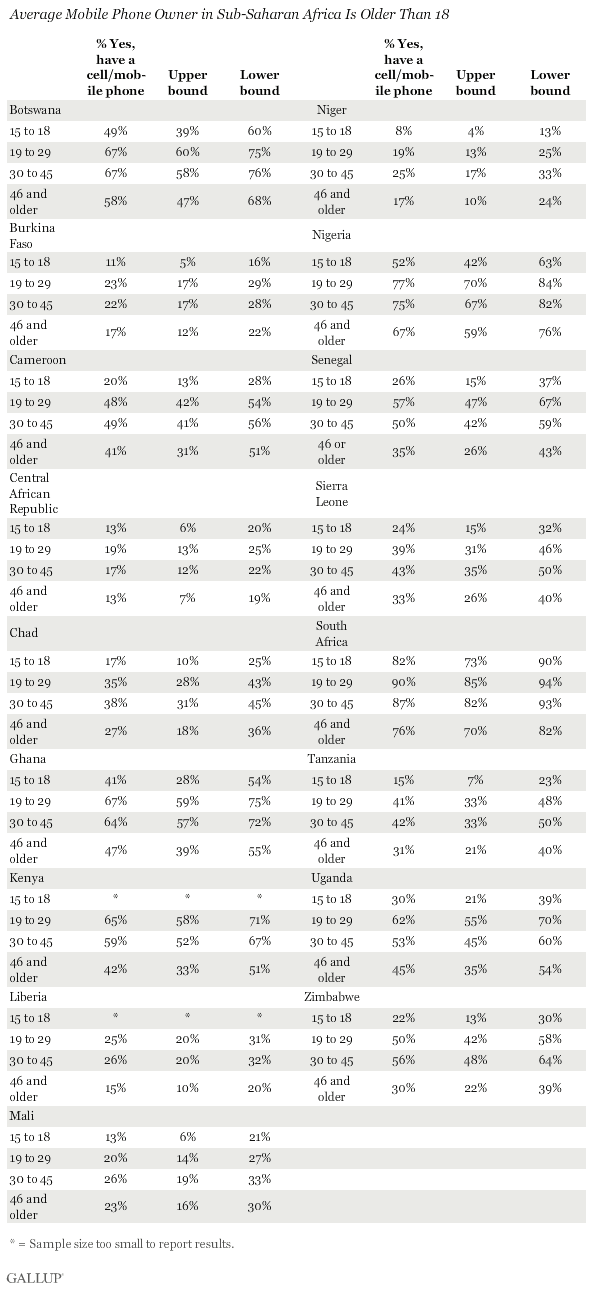This is the first of two articles that examine access to information and communications technology in sub-Saharan Africa.
WASHINGTON, D.C.-- Fifty-seven percent of the adult population -- or more than an estimated 151 million people -- have mobile phones across the 17 countries Gallup surveyed in sub-Saharan Africa in 2010. The percentage of adults with mobile phones ranges from a high of 84% in South Africa to a low of 16% in Central African Republic, signaling the potential for tremendous growth in the industry on the sub-continent.

Mobile telephone subscriptions have grown faster in Africa than in any other region in the world since 2003, according to the United Nations Conference on Trade and Development. Mobile phone adoption rates have soared in countries such as South Africa, where Gallup surveys show more than 8 in 10 adults now say they personally have mobile phones. But penetration still remains relatively low in several countries where adoption rates have been more sluggish, including Burkina Faso (19%), Niger (18%), and the Central African Republic (16%).
Mobile Phone Owners More Likely to Be Male, Older Than 18
The average mobile phone owner in the 17 sub-Saharan countries is more likely to be male (62%) than female (52%) and older than 18. Those between the ages of 15 and 18, and arguably with the least spending power, are less likely to say they have mobile phones than older adults. On average, 40% of 15- to 18-year-olds in these sub-Saharan African countries have mobile phones, but the percentage climbs to 63% among those aged 19 to 29 and remains higher than 60% for those between the ages of 30 and 45. Ownership drops off after that, with 51% of those 46 and older saying they have mobile phones.

The average mobile phone owner is also more likely to be educated. Across the 17 countries surveyed, 75% of those with at least nine years of formal education have a mobile phone, while 44% of those with up to eight years of formal education have a mobile phone. The highest rate of mobile phone ownership at each education level occurs in South Africa, where 76% of those with up to eight years of formal education have cell phones and 91% with higher education do. The lowest rate of mobile phone ownership for those with lower levels of education is 10% in the Central African Republic and the lowest rate among those with at least nine years of education is 40% in Liberia.
Location, Income Make a Difference in Most Countries
Urban sub-Saharan Africans are more likely to be mobile phone owners. Sixty-nine percent of sub-Saharan Africans living in urban areas in the 17 countries surveyed have a mobile phone, while significantly fewer living in rural areas, 53%, do. However, in Ghana (urban 58%, rural 60%), Nigeria (urban 77%, rural 66%), South Africa (urban 82%, rural 86%), and Zimbabwe (urban 54%, rural 39%), urban and rural dwellers are statistically as likely to have mobile phones.
Not surprisingly, household income and mobile phone ownership are also related. Those with a mobile phone report average per capita household incomes near $1,100 and those without a mobile phone report per capita household incomes lower than $740. This income pattern is present in all countries except Botswana, Ghana, Nigeria, and South Africa, where there is no statistical difference in per capita household income.
Implications
Mobile phone access in sub-Saharan Africa ranges widely by country. At the same time, men, those with higher education levels, urban residents, and those with higher per capita household income generally are more likely to have mobile phones. The challenge for the mobile phone industry is to expand from this base to rural and poorer areas, where cost will likely remain an obstacle to growth.
For complete data sets or custom research from the more than 150 countries Gallup continually surveys, please contact SocialandEconomicAnalysis@gallup.com or call 202.715.3030.
Survey Methods
Results are based on face-to-face interviews with 1,000 adults, aged 15 and older, conducted in 2010 in Botswana, Burkina Faso, Cameroon, Central African Republic, Chad, Ghana, Kenya, Liberia, Mali, Niger, Nigeria, Senegal, Sierra Leone, South Africa, Tanzania, Uganda, and Zimbabwe. For results based on the total sample of national adults, one can say with 95% confidence that the maximum margin of sampling error ranges from ±3.4 percentage points to ±4.1 percentage points. The margin of error reflects the influence of data weighting. In addition to sampling error, question wording and practical difficulties in conducting surveys can introduce error or bias into the findings of public opinion polls.
For more complete methodology and specific survey dates, please review Gallup's Country Data Set details.


